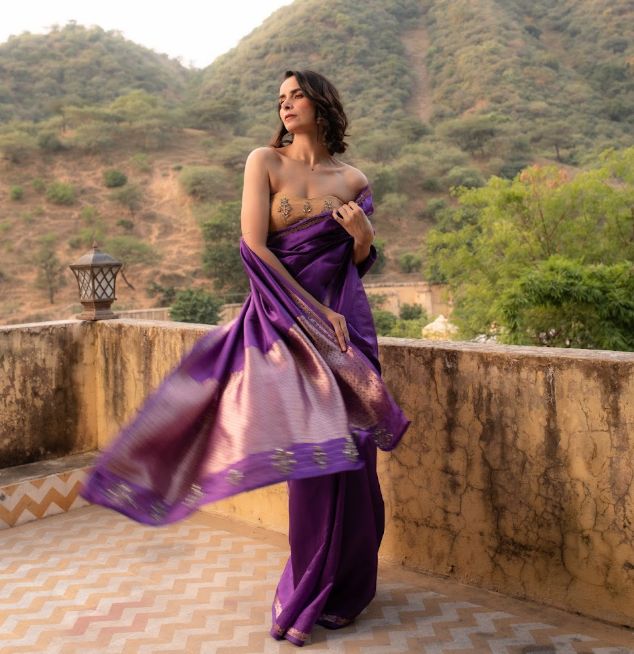Different Types of Saree Draping: Saree Draping Styles
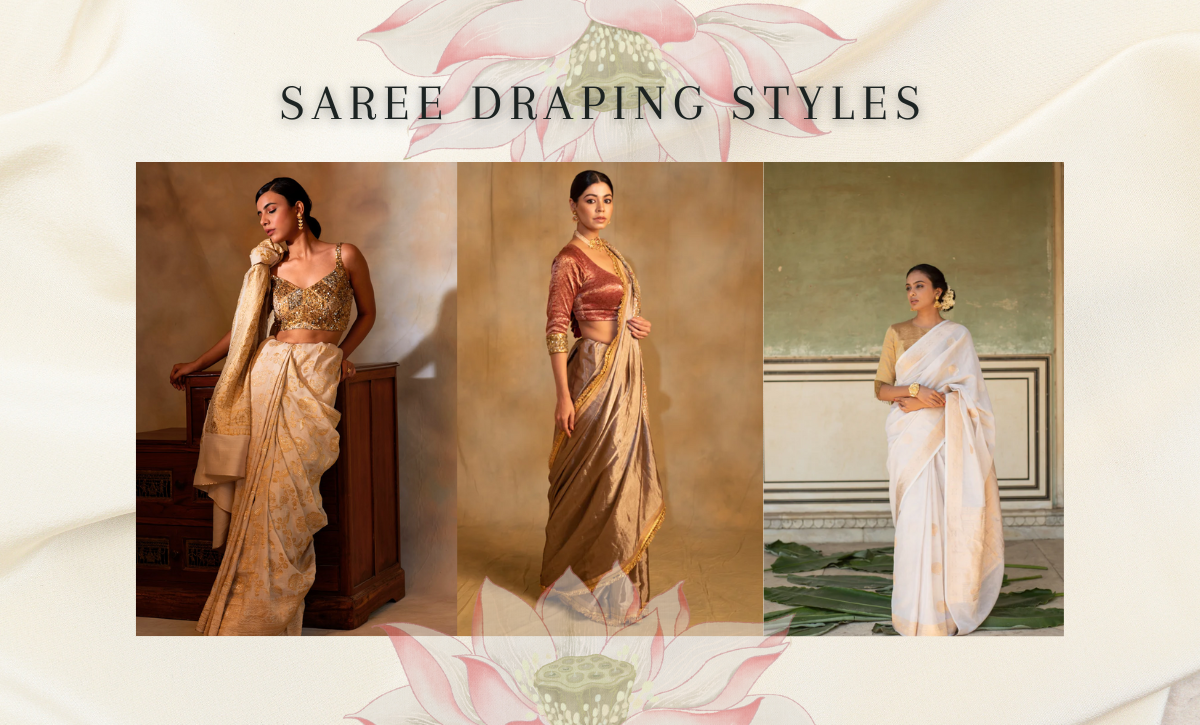
Introduction to Saree Draping Styles
The saree is one of India’s most versatile and elegant traditional garments. Each state has a version that is close to the hearts of the people of that region. Across regions, the saree does not just vary in its fabric and work done on it but also in terms of how it is draped.
Each saree draping style adds to the aesthetic appeal of the garment. Correct saree draping is nothing less than an art form, as it not only requires precision but also creativity.
In this blog, we will cover the different traditional and modern methods of saree draping and step-by-step teach you how you can do it by yourself!
Things to Consider Before Draping a Saree
Before we get into the draping of a saree, here are a few things you should consider:
- Saree Fabric: The fabric and weight of the fabric of your saree will determine the type of saree draping. Lighter fabrics like chiffon and georgette will have to be draped differently as compared to heavier fabric like velvet, silk, or cotton.
- Occasion: The event you are attending, heavily influences the saree draping style. Traditional events like weddings and pujas will require a conservative saree draping style, whereas at casual events like cocktail parties, office parties, and award shows, you can experiment with more modern saree draping styles.
- Body Type: While there is no fixed saree draping style for any body type, certain draping styles tend to accentuate curves, whereas others have a slimming effect. The saree draping style depends on the look you want to achieve.
- Accessories: While selecting your saree draping style you must keep in mind the saree blouse, petticoat, and jewellery you will be wearing. The saree draping style should accentuate your accessories.
Also Check : Silk Saree Blouse Design Ideas
Best Tips to Drape a Saree
Simple yet essential tips to keep in mind while draping a saree
- Choose a saree blouse that suits your shape and the event you will be attending.
- While draping, two things are very important:
- Your pallu (loose end) is of the correct length.
- The saree’s border should be evenly draped at the bottom.
- Place safety pins strategically to ensure that the pleatsare securely placed and the saree does not slip.
- After you drape the saree, ensure you practise walking and sitting to check whether you are comfortable. If not, you must drape your saree again.
Saree Draping Styles: Traditional to Modern
Let's explore the Different types of saree draping styles. We have a wide range of styles to cover, so let's begin by looking at the traditional and modern saree draping styles.
Traditional Saree Draping Styles:
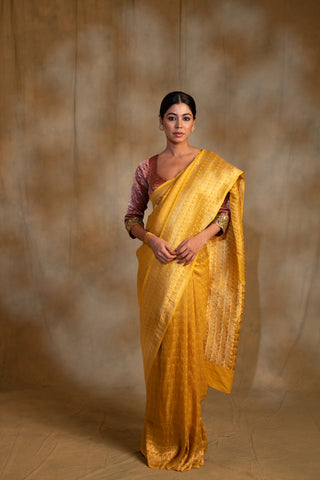
The Nivi draping style is one of the most famous and commonly worn saree draping styles. It can be identified by the pleats and pallu (loose end) draped over the shoulder.
How to Drape Nivi Style Saree Step-by-step guide:- Step 1: Begin draping the saree by tucking the loose end into your petticoat near your belly button.
- Step 2: Neatly fold the saree, create 6-7 pleats and tuck them into the petticoat slightly left of your belly button.
- Step 3: Drape the saree around yourself from left to right.
- Step 4: Take the pallu (loose end) over your left shoulder and pin it into place.
2. Bengali Style Saree Draping:
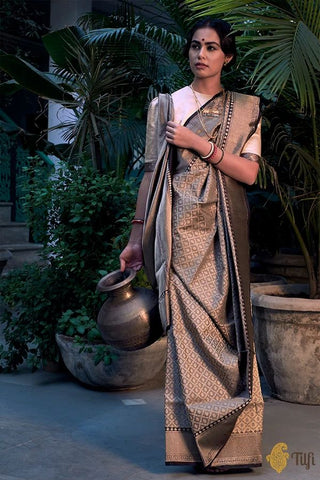
Bengali sarees are recognized by a characteristic red and white border. In this saree draping style the pleats are in the front, while the pallu (loose end) is elegantly draped over the shoulder.
How to Drape Bengali Style Saree Step-by-step guide:- Step 1: Begin by tucking the plain end of the saree into the petticoat and making pleats.
- Step 2: Fold the pallu into pleats and drape it over your left shoulder.
- Step 3: Secure the pallu with a safety pin.
3. Gujarati Style Saree Draping:
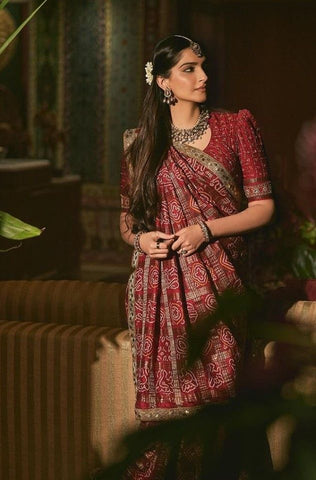
A Gujarati style saree is characterised by the pallu (loose end) being draped in the front and the pleats at the back.
How to Drape Gujarati Saree step-by-step guide:
- Step 1: Start by tucking one end of the saree into the petticoat at the centre.
- Step 2: Fold the pleats and tuck them into the petticoat at the back.
- Step 3: For the pallu (loose end) you will have to take the pallu from the back to the front over the right shoulder.
4. Maharashtrian Nauvari Style Saree Draping:
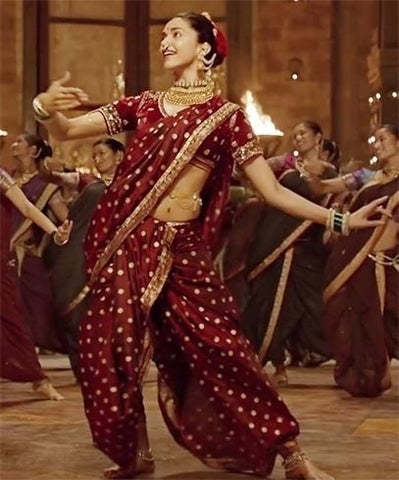
Unlike most sarees that are six-yards in length, the Maharashtrian Nauvari Style draped saree is nine-yards in length. It involves a very unique draping style, let’s break down the steps for you.
How to Drape Maharashtrian Nauvari Saree Step-by-step guide:- Step 1: Begin draping the saree by tucking one end of the saree into your leggings or knee-length tights at the centre. Fold 4-5 pleats towards the left.
- Step 2: Gather the rest of the fabric between your legs and tuck it into the back of the petticoat.
- Step 3: Now take the pallu from the back to the front over your shoulder and secure it with safety pins.
5. Kodagu Style Saree Draping:
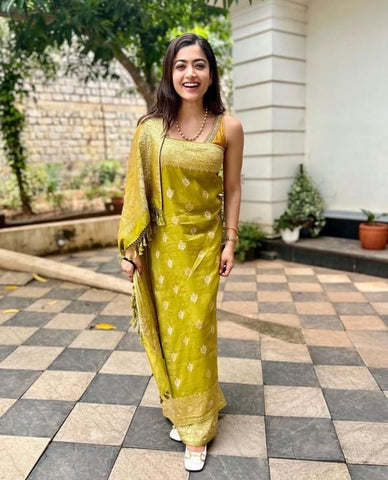
This draping style originated in Coorg, Karnataka. It features a unique pleating style, and the pallu covers the head.
How to drape Kodagu Saree Step-by-step guide:- Step 1: Start by tucking the plain end into the petticoat and folding pleats. Tuck those into the petticoat.
- Step 2: Take the loose end of the saree over your left shoulder and secure it in place with pins.
- Step 3: You can also drape the remaining fabric over your head.
6. Kerala Style Saree Draping:
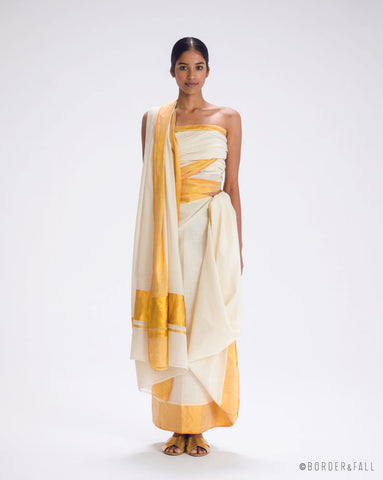
This style of draping is also known as Mundum Neriyathum and is specific to Kerala. It involves two different pieces of cloth. One lower garment, or mundu, and one upper garment, or neriyathu.
How to Drape Kerala Style Saree Step-by-step guide:- Step 1: Wear the lower garment, or mundu, like a skirt and tuck the upper edge into the waist.
- Step 2: Take the upper garment or neriyathu and drape it over your left shoulder.
7. Assamese Style Saree Draping:
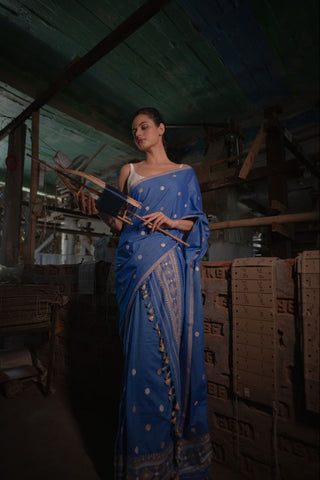
Like the Kerala draping styles, the Assamese style known as Mekhela Chador also consists of two pieces of cloth. The lower garment is called the mekhela and the lower garment is called the chador.
How to Drape Assamese Style Saree Step-by-step guide:- Step 1: Start by wrapping the lower garment or mekhela around the waist and tuck it into the waist.
- Step 2: Take the upper garment or chador and drape it over your shoulder.
Also Check: Banarasi Saree Blouse Designs
Modern Saree Draping Styles:
Now that we have seen the Traditional draping styles, let’s explore modern and unique saree draping styles.
1. Butterfly Style Saree Draping:
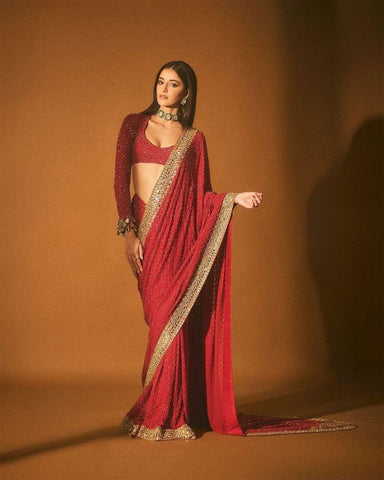
The Butterfly draping style is a very unique style that is commonly worn by celebrities at award functions and weddings. It involves a unique draping of the pleats, which resembles butterfly wings at the back.
How to Drape Butterfly Style Saree Step-by-step guide:- Step 1: Begin by folding pleats in the pallu and draping it over your shoulder. Adjust the length of it to the desired length.
- Step 2: Bring the remaining fabric to the front and start folding pleats on the left and right sides. Tuck it into the petticoat.
- Step 3: Once tucked, spread out the pleats to look like butterfly wings.
2. Dhoti Style Saree Draping:
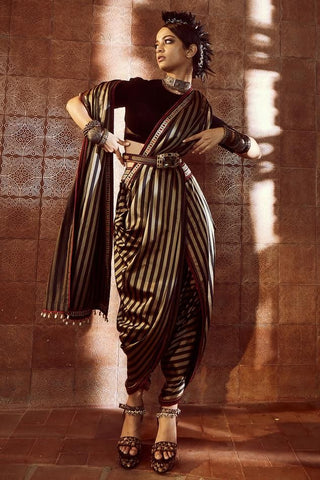
Perfect for those who love to experiment, the Dhoti Saree Draping is characterised by draping a saree like a dhoti, with pleats in the front and the pallu draped around the waist.
How to Drape Dhoti Style Saree Step-by-step guide:- Step 1: Start by tucking one end of the saree into your petticoat at the centre.
- Step 2: Fold pleats at the front and secure.
- Step 3: Now the important step, bring the pallu around the waist and drape it like a scarf.
3. Mumtaz Style Saree Draping:
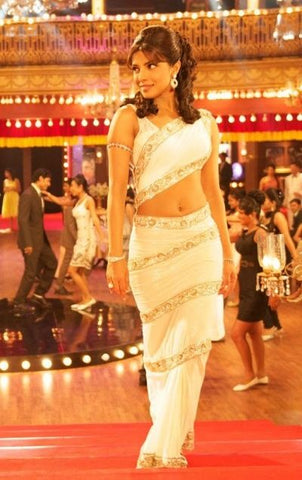
Look like one of Bollywoods most iconic celebrities Mumtaz in this unique draping style which features a unique draping style that creates a layered effect.
How to Drape Mumtaz Style Saree Step-by-step guide:
- Step 1: Start by tucking one end of the saree into your petticoat near your belly button.
- Step 2: Fold small pleats and tuck them in, leaving some of the fabric loose.
- Step 3: Bring the rest of the fabric over your right shoulder and drape it diagonally across your body, creating layers.
4. Off-Shoulder Style Saree Draping:
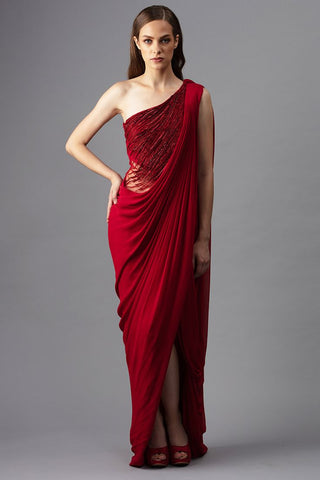
All eyes will be on you when you drape the pallu in an off-shoulder fashion, creating a trendy look.
How to Drape Off-Shoulder Saree Step-by-step guide:- Step 1: Start by folding the ends of the saree into pleats. Tuck at the waist.
- Step 2: Drape the pally across your chest while leaving one shoulder exposed.
5. Mermaid Style Saree Draping:
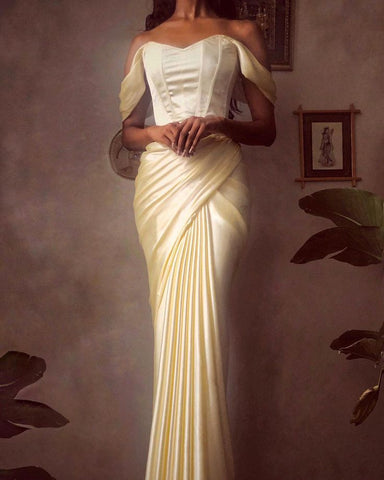
For your next event, look like a mermaid with this saree draping style, that creates a fitted silhouette that shows off your curves.
How to Drape Mermaid Style Saree Step-by-step guide:
- Step 1: Start with tucking one end of the saree into your petticoat.
- Step 2: Tightly wrap the saree fabric around you and make small pleats. Tuck them tightly to create a fitted silhouette.
- Step 3: Bring the pallu over your left shoulder and drape it diagonally across your body.
6. Gown Style Saree Draping:

A unique and classy look where your saree draping looks like a gown.
How to Drape Gown Style Saree Step-by-step guide:- Step 1: Tuck one end of the saree into your petticoat. Make pleats and tuck at the centre.
- Step 2: Ensure you choose a blouse with a v shaped neckline and dramatic sleeves.
- Step 3: Bring the pallu over your left shoulder and drape it diagonally across your body. Finish the look with a belt.
7. Indo-western Fusion Saree Draping Style:
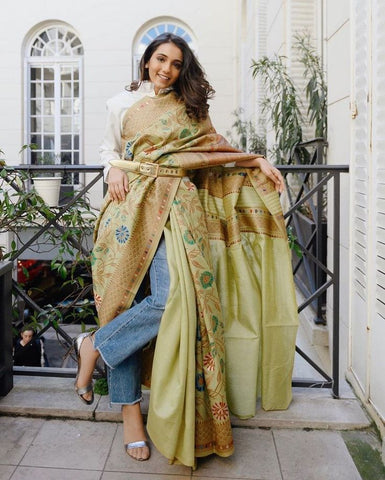
Be the centre of attention at your next event in this Indo-western draping style. For this unique look you can ditch a traditional petticoat and wear fitted jeans or printed pants.
How to Drape Indo-Western Fusion Saree Step-by-step guide:- Step 1: Start by folding one end of the saree into pleats, taking it over one shoulder, and pining it into place.
- Step 2: Fold the other end of the saree into pleats and take it over your other shoulder.
- Step 3: Make small pleats of the remaining material and tuck it into your jeans or petticoat at the back.
- Step 4: Finish the look by wearing a belt at the waist.
This covers some of the unique and modern ways in which you can drape a saree at an upcoming wedding reception, cocktail party or black-tie event.
Also check : BACK DESIGNS FOR SAREE BLOUSES
Conclusion:
Priyanka Raajiv offers you a beautiful collection of sustainable sarees that can be draped in both traditional and modern ways. Sarees are available in a variety of materials, like Maheshwari, Banarasi, Chanderi, Cotton, and even in Jod (upcycled fabric).
When it comes to saree draping style, there is a lot of room for experimentation and expression of your creativity and style. While choosing a draping style for your next event keep in mind the nature of the event you are attending, the fabric of your saree and the type of blouse, shoes, and jewellery you will be wearing. Remember, there is no fixed saree draping style for any body type, so ensure you choose a style that flatters your figure the best.
FAQ
Q1. How to Drape Saree Uniquely?
Ans. There are a lot of unique and modern ways in which you can drape your saree. Butterfly, Dhoti, and Mermaid styles are very common among fashionistas.
Q2. Which Is the Most Common Saree Drape?
Ans. Nivi style saree draping is one of the most popular and easy ways to drape a saree. It flatters every body type and looks stunning at both traditional and casual events.
Q3. Which Type of Saree Is Easy to Drape?
Ans. A pre-stitched or ready-to-wear saree can be the easiest to wear. But with a little practice and the will to experiment, you will easily be able to drape a saree in a traditional and modern way.
Q4. How Many Styles of Saree Draping Are There in India?
Ans. Sarees are one of the most commonly worn across India. Different regions have their own ways of draping a saree. There are at least 80 different versions across different states and communities in India.
Q5, What Is the Oldest Way to Wear a Saree?
Ans. The Nivi drape is considered to be one of the oldest styles of saree draping in India.

